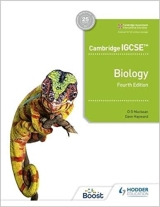Chapter 5. Photosynthesis and nutrition in plants
Page 38
1. a carbon dioxide, d water, e chlorophyll, g light.
2. The white parts of the leaf do not contain chlorophyll and act as a control.
3. ‘Destarching’ a leaf means taking steps to ensure that it does not contain starch at the beginning of the experiment. If the leaves already contain starch it cannot be demonstrated that a particular process is necessary for the production of starch.
4. a Soda lime absorbs carbon dioxide and so the leaf is deprived of this gas.
b Sodium hydrogen carbonate in solution decomposes to form carbon dioxide. This ensures that the plant has an adequate supply of this gas.
c The polythene bag prevents carbon dioxide in the air from reaching the plant.
5. By using pondweed it is possible to see the bubbles of gas escaping from the leaves. The choice of pondweed might lead to the claim that production of oxygen in light happened only in pondweed.
6. Depriving a plant of water would lead to wilting and, ultimately, to the death of the plant irrespective of the role of water in photosynthesis.
7. Yes. Destarching is achieved by leaving a plant in darkness for 2 or three days for starch to be removed from the leaves. It is assumed that no new starch will be formed in darkness.
Page 39
1. Carbon dioxide from the air. Water from the soil.
2. a The palisade cells. They have the greatest number of chloroplasts and are nearest the light source.
b The spongy mesophyll cells. They have fewer chloroplasts and are further from the light source.
c The cells of the epidermis. They have no chloroplasts
3. a The energy for photosynthesis comes from sunlight.
b Respiration is the source of energy for all other living processes.
Page 41
1. a In bright sunlight a leaf would be taking in carbon dioxide and giving out oxygen.
b In darkness a leaf would be taking in oxygen and giving out carbon dioxide.
2. No. It may just mean that respiration is taking place faster than photosynthesis.
3. You would need to gradually increase the light intensity, (e.g. by moving the light source closer to the tube), until the indicator just changed colour. Ideally then you could use a light meter to measure this intensity. With the high light intensity in a field, you would expect plants to reach compensation point quickly. In the low light intensity of a wood you might expect plants to take to take longer to reach compensation point.
Page 44
1. a carbon dioxide and water. Chlorophyll must be present.
b nitrate ions. Enzymes must be present.
2. The carbon dioxide molecule would be combined with water to make glucose. Some of this glucose might be respired, releasing the carbon dioxide molecule.
3. a Raising the temperature will increase the rate of reactions in photosynthesis. Increasing the light intensity will speed up photosynthesis and so will an increase in the carbon dioxide concentration
b It depends on what the limiting factors are. It would not be cost effective, for example, to increase carbon dioxide concentration if a low light intensity is limiting the rate of photosynthesis.
4. In darkness, from midnight to 4.0 a.m. only respiration will be taking place and so the carbon dioxide concentration will be increasing. From 4.0 a.m. to 8 a.m. photosynthesis will be starting up as the light intensity increases and so more and more carbon dioxide is used by the crop. From 8.0 a.m. to 4.0 p.m. photosynthesis will be at its peak, using up carbon dioxide. As the light intensity diminishes after 4.0 p.m. photosynthesis slows down while respiration stays the same so that more carbon dioxide is released than is retained.
Page 46
1. Magnesium sulphate, potassium phosphate and a soluble calcium salt, e.g. calcium chloride.
2. a Calcium and phosphorus. b iron.
3. The floating plant needs carbon dioxide and water for photosynthesis and its roots absorb water directly from the pond.
4. a Without nitrates, the plant cannot make the proteins which are needed to make the cytoplasm required for growth.
b Phosphates are used to make DNA, which is needed for cell division (growth).
5. a The yield is increased from about 6 tonnes per hectare to 7.2 tonnes. A gain of 1.2 tonnes per hectare.
b The yield increases by about 1.5 tonnes per hectare (8.7 - 7.2).
c Increasing the applied nitrogen from 150 to 300 kg per hectare would increase the yield by only about 0.6 tonnes per hectare. The farmer needs to work out whether this is less than the cost of the extra fertiliser. |
Downloads
Download the answers in PDF format below
Section 1, Chapters 1-5
Section 2, Chapters 6-9
Section 3, Chapters 10-12
Section 3, Chapters 13-17
Section 3, Chapters 18-20
Section 4, Chapters 21-24
Section 5, Chapters 25-27
Section 5, Chapters 28-29
Section 6, Chapters 30-34
Section 6, Chapters 35-37
Section 7, Chapters 38-39
Section 8, Chapters 40-41
|
